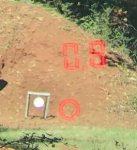I've gotta know.... You can actually hold to the hundredth? Or it just one of those things that bugs you for no real reason?
A question back at you: does 1/3 of a MOA matter?
The absence of the hundredths place does not mean +/- 0.01. It means the range of 0.00 to 0.09. This is a significant difference.
We saw an output of 0.82 from the Kestrel reflected as 0.8 in the BDX. Without looking at the Kestrel how could we interpret 0.8? We just need to understand how numbers are rounded, in this case from hundredths to tenths.
0.8 shown in the BDX represents the range of outputs from 0.75 to 0.84 in the Kestrel.
In the below chart we see the angular measurement in inches as we go from 0.75 to 0.84 mils from 100 to 1,200 yards. At 100 yards an output of 0.8 in the BDX can mean a range of 2.7" to 3.0", or 0.34 MOA. The target ranged was 253 yards and the range of values is still 0.34 MOA.
How do we do this? By observing the rules for rounding decimals to the nearest tenths:
- To round a decimal analyse the digit at the hundredths place.
- If the hundredths place value is 5 or more than 5, then the digit at the tenths place increases by 1 and the digits at the hundredths place and thereafter becomes zero.
Does it matter? YES! My match rifle is an honest 0.5 MOA gun. The range of values shown above indicate I can add up 0.34 MOA to that based on the imprecision of the hold presented. At 0.84 MOA I am back to the reloading bench to figure things out.
I am sure some reading this have already figured that I should be measuring the distance from 0.8 to get a +/- loss of precision for bullet placement and not the whole range. This is true and is why I have chosen to keep the BDX.
In all fairness I haven't spoken to anyone at Sig about this.



